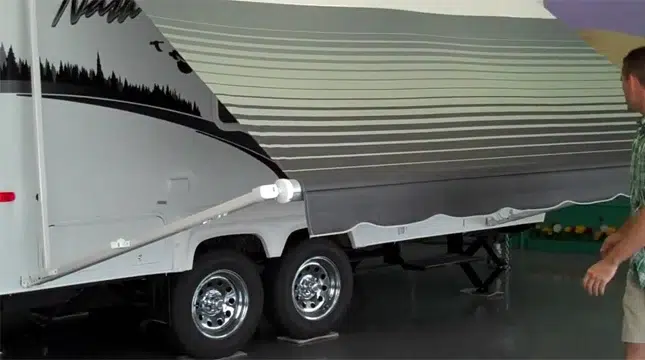Last Updated on April 15, 2023
Rolling up an RV awning is essential for ensuring that the awning remains in top condition and protecting it from the weather. It can be intimidating for RVers who are new to this rolling-up process. So they always look for a fast and easy solution on how to roll up an RV awning in harsh weather.
To roll up your RV awning, you should begin by cleaning the awning of any dirt or debris. Attach the awning arms to your RV. Once this is done, ensure both rafter arms are lowered and secure.
Starting from one end, slowly roll up the fabric until it is snugly tucked away into its storage position on the RV’s armature.
Make sure to lock it into place before releasing the handlebar so it cannot come undone when you’re not around. Load the straps onto their respective brackets for further security.
Here we’ll provide clear and detailed instructions to properly roll up your RV awning. We’ll also cover some of the most common problems of not folding RV awnings and how to avoid them.
How to Roll up RV Awning – Complete Instructions for Spring loaded or Manual RV Awning
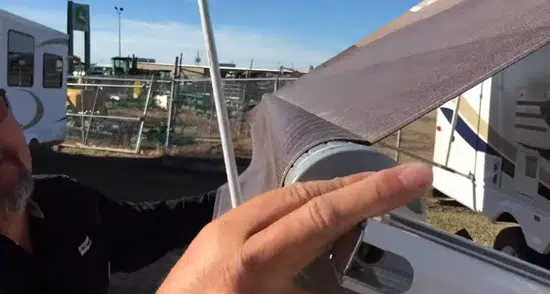
Rolling up your manual spring-loaded awning is an integral part of RV maintenance. It protects the awning from harsh weather conditions and prevents the fabric from tearing or fraying over time. This step-by-step guide will help you properly roll up and store away each time.
Step 01) Check for Damage & Clean the Awning:
Check it for any damage that may have occurred during the last use. Look for signs of tears or fraying in the fabric, and ensure that all the components are securely attached.
If there is debris, such as twigs, branches, leaves, and pinecones on the retractable awning, take some time to remove them using a soft brush. You may need to invest in an appropriate awning cleaner solution for harder-to-remove stains.
Read through the instructions carefully before applying it onto your RV awning fabric. Once done cleaning, wait to dry before rolling the awning back in.
Step 02) Attach Awning Arms To RV:
Remove any stakes that may be propping up the awning if it has been open for extended periods, then attach each arm back onto the RV walls with appropriate screws or bolts. Make sure they are securely fastened before continuing on to lower them into place.
Step 03) Lower Awning Arms:
Lower each awning arm gently until they’re almost touching ground level. As they come down into place, twist and loosen their respective rafter knobs so that they can lay flat against whatever surface they’re resting on without being held up by tension from these knobs.
Step 04) Lower Rafter Arms:
Once both arms of your manual spring-loaded, the awning almost touches ground level, and its rafter knobs are fully loosened. Pull back each inner arm into its respective slots in the RV wall until each one clicks into place securely with an audible “click” sound indicating proper installation.
Step 05) Roll In The Awning:
Flip over the locking lever located near either end until it hits Close mode. Then hold onto both awning strap loops tightly (one with each hand) while standing in between both shade surfaces directly above the center point. This will help evenly distribute weight along the entire length while winding.
From there, slowly but firmly continue winding/rolling back until the entire surface has been fully retracted into its original form.
Step 06) Lock And Load:
Turn clockwise on all four knobs found near entrance points (two at either end) until they cannot be turned anymore. Then take two straps provided within the box kit and loop through handle openings before securing tight around the nearest anchoring points found near entrance points.
Secure the highest point along the entire length with a tie loop provided before dragging out the bag over the entire surface for safe storage once finished.
How Do You Manually Roll Up an Electric Awning?
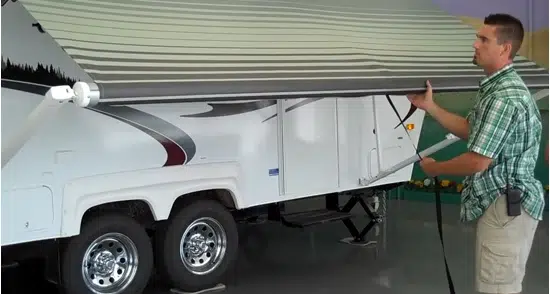
Manually retracting an electric awning can be done in a few simple steps. It is important to follow the instructions below to ensure your awning is properly retracted and secure.
Step 1) Turn off Power Source:
Locate the controls for the motorized awning. It is usually located on the side of the house or by the door leading out onto the patio. Using either a remote control or wall switch, disengage the motor from its power source.
Step 2) Locate Retracting Mechanism:
Identify which type of electric awning you are working with so that you can access and utilize its retracting mechanism properly. When you know what kind of system yours uses, look for its lever rod tip and find out where it is located in relation to your awnings’ frame structure.
Step 3) Open Any Locks:
Check for any hidden locks on your system by gently pushing down on different parts. If necessary, you may also use a flashlight and open them before starting your crank lever process.
Step 4) Begin Cranking Lever Rod:
With all the preparations taken care of, it’s time to start cranking the lever rod. Insert your lever rod into its corresponding slot in the retracting mechanism, as this will help support its manual retraction process and reduce wear and tear during cranking.
Start slowly and steadily turning your lever until you see your electric awning beginning to close up. Crank faster if needed but always at steady intervals for best results.
Step 5) Close Awning Fully:
Keep turning your lever until you feel resistance. This means all parts have been properly retracted and locked into place. Otherwise, this could cause permanent damage.
Double-check if there are any adjustments or repairs needed for optimal functioning before concluding this process as complete.
Why Does a Manual or Electric Awning not Retract?
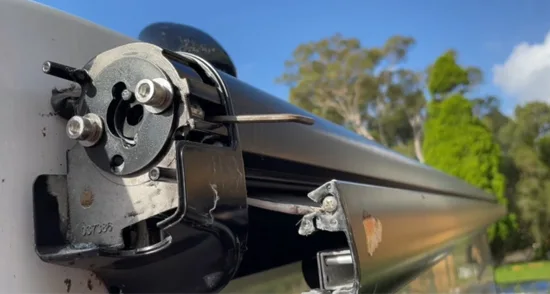
Awnings are a great way to keep your outdoor spaces cool, comfortable, and shaded. However, over time, the mechanisms that operate them can become faulty or loose, leading to them not retracting properly.
Here we will be looking at why manual and electric awnings do not retract and what can be done to rectify the issue.
Reason 01) Screws on the Awning Chords Are Loose:
Loose screws on the chords of an awning can cause an inability to retract or close the manual awning correctly. This is especially true in manual awnings, as they require extra tension on their chords in order for them to work effectively.
Solution:
Inspect all screws holding the chord system down and tighten any that look loose. If any screws appear to be rusted, this could indicate larger problems, so it might be necessary to replace them entirely with new ones.
Reason 02) The Awning is not Positioned Evenly on The Rail:
If an awning is not correctly mounted onto its rail, it can cause retraction issues. And especially if there is uneven pressure applied from one side being higher than the other.
Solution:
Secure the manual or electric rv awning firmly in place before attempting any repairs. If necessary professional help should be consulted in order to ensure proper installation and positioning of the unit before use.
Reason 03) Move the Awning’s Arms:
Another cause of non-retraction in both manual and electric models of awnings could be the incorrect placement of their arms into their slots when extended outwards.
It can also occur if too much pressure has been applied when moving these arms back into position when opening or closing, as this can lead to them becoming jammed within their slot mechanism.
Solution:
Reset their unit’s settings, while those with manual models should check all arms are correctly slotted into place before attempting retraction again.
Reason 04) The Awning Fabric Has Gotten Warped:
If an awning’s fabric becomes warped, then this can stop it from closing fully as its material will no longer fit snugly around its frame, thus preventing any meaningful operation from occurring until resolved.
Solution:
Check for signs of wear-and-tear damage on individual parts such as buckles, straps, clips, etc. Then adjust or replace altogether if necessary while ensuring that all fabric pieces have been securely fastened into place using high-grade nylon thread or strong Velcro strips etc.
Reason 05) Awning’s Electrical Issues:
Awnings fail at closing correctly either due to wiring faults inside these systems themselves or because battery power has been drained completely after long use. Check that all connections are secure and that there are no broken wires before attempting further repairs yourself.
Solutions:
Check connections between wires/components, remove dust build-ups from plugged-in equipment, etc. If the issue persists, it’s best to contact an experienced professional who can take care of any electrical repairs needed safely and efficiently.
Should You Leave Your Awning Out in The Rain?
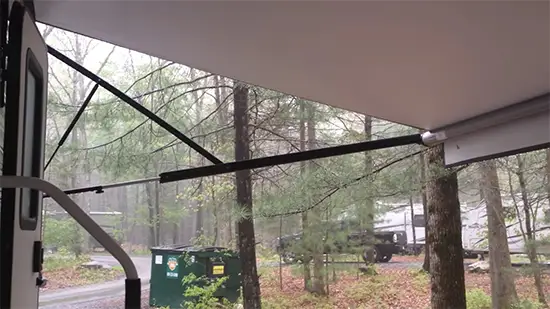
No, it is not recommended to leave an awning out in heavy rain, as it can damage the material and reduce its lifespan. Leaving an awning outside unattended during a rainstorm can cause considerable damage to the fabric and frame.
Additionally, the awning could become waterlogged, which could cause sagging and weight issues that could compromise its structural integrity.
Can You Roll Up A Wet Awning?
It is generally okay to roll up a wet awning for one or two nights. But it is best to let the awning dry out before retracting it.
It usually takes 2 to 3 hours for the fabric of the awning to soak up all the water. If you have the option, allowing your awning to dry before folding in will help prolong its life and keep it functioning safely and properly.
What Wind Speed Should You Retract Your Awning?
Most self-supporting retractable awnings are designed to withstand winds of approximately 20mph. But, it is important to check the manufacturer’s wind rating for your specific type of awning, as these ratings may vary.
Generally, larger fabric awnings such as patio covers or cabanas will have lower wind ratings than smaller options such as window and balcony shades. The wind ratings of these products are usually measured in either km/h or the Beaufort scale for reference.
When Should You Not Use An Rv Awning?
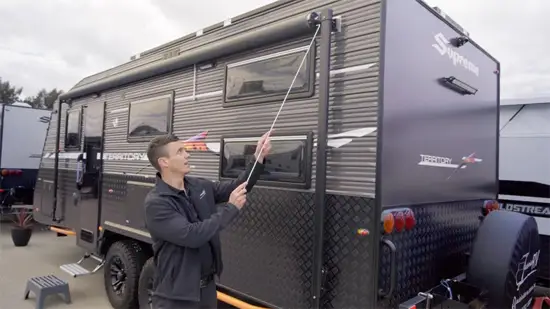
We don’t recommend you use an RV awning in strong winds. The force of the wind can be powerful enough to damage the awning fabric or cause it to become unbalanced and potentially collapse.
It is also not advised to leave an RV awning open for cover during rainfall. The extra weight of accumulating water droplets can become too heavy for the fabric support and cause the awning to stretch or even tear.
You may need to replace the awning fabric if it is covered with mold, mildew, or rot from long-term exposure to sun and rain.
When Should I Roll Up My RV Awning?
It is best to dry the awning completely before rolling it up, as wet material can permanently damage it. Cleaning the awning before rolling it up will help to prevent dirt and debris from building up over time. Doing so will also help keep it in top condition for a long time.
So you now know when and how to roll up rv awning and common issues not to retract it. With proper maintenance and care, your awning should provide you with years of enjoyment.

